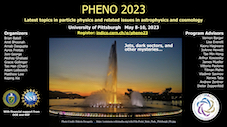Speaker
Description
Dark matter may exist as an ultralight bosonic particle, leading to the formation of an ever-present field that could interact with us via a new long-range fifth force. Recently, quantum sensing techniques have been shown to be promising avenues with which to detect such a dark matter candidate. However, these studies did not entirely capture the stochastic nature of the field, which is important to construct realistic exclusion limits and discovery regions. In this talk, I will show how an experiment employing an array of optomechanical sensors can be used to place leading bounds on ultralight dark photon dark matter via an improved statistical treatment. I will highlight the different statistical regimes required depending on how long the dark matter field is observed. I will then derive a general exclusion limit on ultralight dark photon dark matter through the paradigm of the canonical optomechanical light cavity, further interpreting this limit in the context of concrete, well-motivated dark photon models. Our results demonstrate that an array of optomechanical sensors would form a powerful probe of ultralight dark matter.

